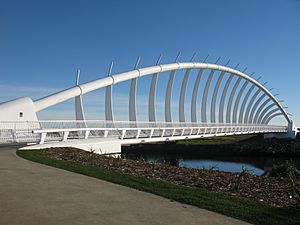Te Rewa Rewa Bridge facts for kids
Quick facts for kids Te Rewa Rewa Bridge |
|
|---|---|

Te Rewa Rewa Bridge with Mount Taranaki in the background
|
|
| Coordinates | 39°02′16″S 174°06′43″E / 39.037778°S 174.111944°E |
| Carries | pedestrians, cyclists |
| Crosses | Waiwhakaiho River |
| Locale | New Plymouth, Taranaki, New Zealand |
| Official name | Te Rewa Rewa Bridge |
| Characteristics | |
| Design | steel arch |
| Material | steel, concrete deck |
| Total length | 70 m |
| Width | 2.5 m |
| Height | 10 m at highest point |
| Longest span | 68.8 m |
| Number of spans | 1 |
| Piers in water | nil |
| Clearance below | 4.5 m |
| History | |
| Designer | Novare Design Ltd |
| Constructed by | Whitaker Civil Engineering |
| Construction begin | 2008 |
| Construction end | 2010 |
| Opened | 5 June 2010 |
The Te Rewa Rewa Bridge is a special bridge in New Plymouth, New Zealand. It's a path for people walking and riding bikes over the Waiwhakaiho River. People love its amazing shape and how it looks in the beautiful landscape.
Contents
Where is the Bridge?
The Te Rewa Rewa Bridge is part of the Coastal Walkway. This walkway is a long path that lets people walk or bike along the coast. The bridge helps connect New Plymouth with a nearby area called Bell Block.
Building this part of the walkway was possible thanks to a special agreement. It was made between the local council and a Māori group called Ngāti Tawhirikura hapū.
Near the bridge, on the north side of the river, there's a historic pā. A pā is a traditional Māori village or fort. This spot was once the site of a battle during the Musket Wars. It is also a burial ground, known as Rewa Rewa. The bridge is in a quiet, semi-rural area.
How the Bridge Was Designed and Built
The New Plymouth District Council asked for this bridge to be built. Several companies worked together on its design and construction. These included Whitaker Civil Engineering, Novare Design Ltd, Apex Consultants Ltd, and Fitzroy Engineering. The money for the bridge came from the New Plymouth District Council and the Whitaker family.
Bridge's Unique Look
The main designer, Peter Mulqueen, wanted the bridge to "touch lightly" on the Rewa Rewa side of the river. This was to show respect for the people buried there. Because of this, he avoided heavy designs.
Mulqueen hoped the bridge would have a "harmonious and dignified character." He said that the bridge's curved parts look like they are bending to the wind. The bridge also lines up perfectly with Mount Taranaki. When you leave the sacred ground, the mountain appears framed inside the bridge's arch. This view is meant to remind people of what is lasting and eternal.
Building the Bridge
The bridge is about 68.8 metres (226 ft) long. It is strong enough for an ambulance or other service vehicles to cross. It is made from three large steel tubes. Two tubes are under the bridge deck, and the third one, along with 19 ribs, forms the unique arch shape.
Builders used 85 tonnes of steel for the main structure. They also used 62 tonnes of steel for reinforcing and 550 m3 (19,000 cu ft) of concrete. The bridge deck is placed 4.5 metres (15 ft) above the normal river level. This helps it stay safe during floods and even lahars (mudslides from volcanoes).
One big challenge was moving the huge, 85-meter-long, 85-tonne bridge structure to the site. They even had to cross a private golf course! To protect the river, they made sure not to use any temporary supports in the water.
Opening Day
The Te Rewa Rewa Bridge officially opened on June 5, 2010. In its first full month, over 55,756 cyclists and pedestrians used the bridge.
Awards the Bridge Has Won
The Te Rewa Rewa Bridge has received many awards for its design and engineering:
- 2011 Arthur G. Hayden Medal for outstanding bridge engineering.
- 2011 Ingenium Excellence Awards.
- 2011 International Footbridge Award for its beautiful design (medium span).
- 2011 Supreme Award from Roading New Zealand.
- 2011 Taranaki Master Builders supreme award for a commercial building.
See also
 In Spanish: Puente Te Rewa Rewa para niños
In Spanish: Puente Te Rewa Rewa para niños


